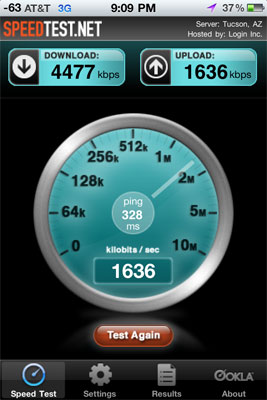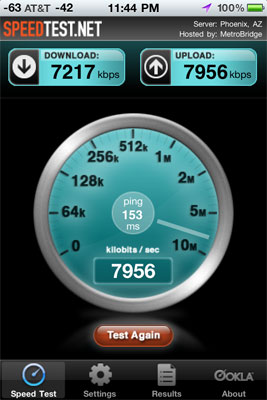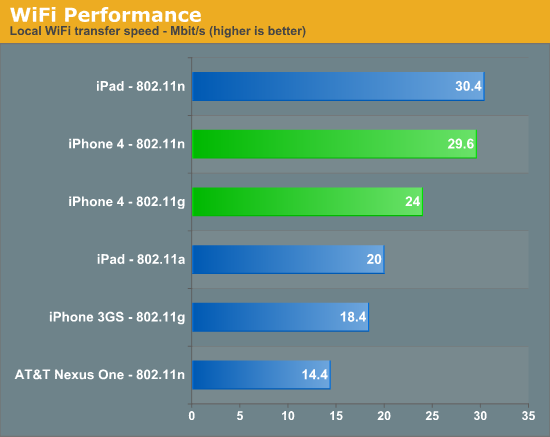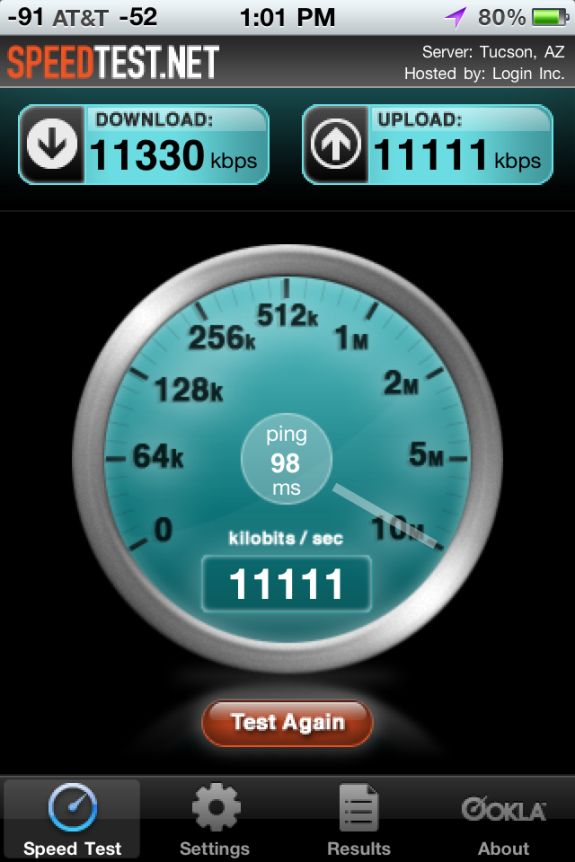Apple's iPhone 4: Thoroughly Reviewed
by Brian Klug & Anand Lal Shimpi on June 30, 2010 4:06 AM EST- Posted in
- Smartphones
- Apple
- iPhone 4
- Gadgets
- Mobile
Network Improvements
The iPhone continues to be an AT&T exclusive in the US. With the iOS 4 upgrades the iPhone 4 supports tethering over Bluetooth or USB. The feature is an extra $20 per month on top of your existing iPhone data plan and it also deducts bandwidth from the 2GB you get with the data plan. It's not a coincidence that AT&T timed the release of its iPhone tethering option with the move away from unlimited data plans. You don't have to give up your existing unlimited data plan if you don't want to, however if you want to enable tethering you have to sign up for the new $25/2GB plan.
I'm not a huge fan of iPhone tethering right now because despite paying for the service and having full signal strength on AT&T, I'm getting horrible transfer rates while trying to upload this article. I had to sign up for airport WiFi to get it live, thanks AT&T. When it does work however, it works well. As you'll see later you can easily get multiple Mbps out of AT&T's network in areas with good coverage. That easily equals the lower end of what you'd see from WiMAX today. As I've mentioned before however, it's really hit or miss with AT&T. The network is either great or totally unusable, while its competitors are generally more consistent but never quite as fast. I'd say that there's a good chance Apple will bring the iPhone to Verizon, it's just a matter of when.
| Cost of Ownership Comparison | |||||
| AT&T iPhone 4 | Sprint EVO 4G | Verizon HTC Droid Incredible | |||
| Cost of Device | $199 w/ 2 year contract | $199 w/ 2 year contract after $100 MIR | $199 w/ 2 year contract | ||
| Plan with 900 Minutes, Unlimited SMS/Data | $104.99/mo, unlimited SMS, 2GB data | $99.99/mo, unlimited SMS, unlimited data, 4G | $109.98/mo, unlimited SMS, unlimited data | ||
| Tethering | + $20/mo | + $29.99/mo | + $25/mo* | ||
| Total Monthly + Tethering | $124.99/mo | $129.98/mo | $134.98/mo | ||
| Total Cost of Ownership over 2 Years | $2718.76 | $2598.76 after $100 MIR | $2838.52 | ||
| Total Cost of Ownership over 2 Years w/ Tethering | $3198.76 | $3318.52 after $100 MIR | $3438.52 | ||
AT&T's plans are actually reasonably priced if you don't go over the data limits. A $15/mo data plan will get you 200MB of transfers per month and $25 will give you 2GB. For users like my parents the 200MB option is great. Even for me personally, 2GB is fine. I tend to peak at 700MB per month, but that's because at the office I'm almost always on my desktop or connected via WiFi. It's unclear how tethering is going to change this for me. Our own Brian Klug on the other hand easily pushes more than 2GB of transfers per month. So AT&T's rate switch is either going to save you a few bucks per month or make you really unhappy.
The iPhone 4 brings HSUPA class 6 for upload speeds of up to 5.76 megabits/s to the platform. This is a 15 fold improvement over the 384 kilobits/s maximum of the iPhone 3G and 3GS, which I routinely see. Not all AT&T markets are updated to HSUPA, and in practice I saw uploads of around 1.5 megabits/s, in line with class 2 or class 3 HSUPA.
Downstream HSDPA speeds remain unchanged from the 3GS, supporting up to 7.2 megabit/s HSDPA. I'm lucky since my market is HSDPA 7.2, as I routinely see speedtests of 5 megabits/s or above very late at night when there isn't very much plant load. I haven't seen any measurable increase in speeds over the 3GS, except in locations with very low signal as noted before.

My fastest iPhone 4 speedtest so far
Even Anand in one of the slowest 3G cities in the US saw significant improvements with the iPhone 4. AT&T's network in general seems to be improving. While the best he'd been able to achieve was around 1Mbps a year ago, these days he can break 2.5Mbps down during the evenings.

iPhone 4 speedtest in Raleigh, NC
WiFi speeds have also improved, as Apple has added 802.11n in the 2.4 GHz band. 5 GHz support remains absent, something which would have likely complicated antenna design even further. Interestingly enough, the BCM4329 WiFi and Bluetooth SoC does contain 802.11a 5 GHz support, the reason it's disabled is again likely due to antenna design constraints. The Broadcom SoC also includes an FM tuner and transmitter, though support for either remains and sadly (given Apple's historical lack of FM radio support) will remain such. Bluetooth 2.1 EDR is there as well.
The iPhone 4 seems to connect at 802.11n rates of 72 megabits/s in best case, far from the maximum without channel bonding of 150 megabits/s. This is still a welcome improvement from the 802.11b/g in the iPhone 3GS, which seemed to never connect above b rates in practice. As an aside, mobile devices using 802.11b rates (modulated using DSSS) are a huge contributing factor to WiFi congestion at conferences - I've even seen DSSS modulated rates (and thus 802.11b devices) explicitly disallowed from connecting to APs at conferences. It's a welcome improvement to see iPhone bringing N support.

A typical WiFi test result
However, even on my 25/4 DOCSIS 3 cable connection, I could only squeeze out a maximum of 8.5 megabits/s down and 8.0 megabits/s up while connected at 72 megabits/s best case. This was using the speedtest.net app to a local test location. I tried with an Airport Extreme (new generation), a WRT600N running DD-WRT, and a WRT54GL-TM running Tomato. All three showed similar results capping out around 8 megabits/s down when I could run tests in excess of 30 megabits down on my desktop. This is probably more of a CPU bottleneck appearing than anything else.
Update:
I thought there was something wrong with my WiFi performance, turns out the iPhone 4 is indeed faster than a palty 8 megabits/s. ;)
There were a number of comments by folks who were able to run speedtest.net and get throughput above 10 or 11 megabits/s. Testing earlier today on a much faster connection, I managed to get something in line with their numbers:
Early today, the folks at DigitalSociety also managed to get much faster WiFi speeds in the neighborhood of 20 megabits/s, way higher than my meager 8 megabits/s. To do so, they loaded an MP3 in safari stored on a local webserver and watched network utilization. I wish I had thought of this, because it's perfect. In the past, the speedtest.net app always used to saturate my connection over WiFi. My only explanation is that the application performs slower over WiFi in iOS 4 than it did in iOS 3, something Anand noted as well. Thanks for all the heads up messages, everyone!
I set up a similar test to DigitalSociety's. I opened an 85 MB PDF stored on my local web server in the browser of each device and watched network utilization using bwm-ng. I tested with an Airport Extreme connected over gigabit to my webserver with no other network utilization. I took the average of 5 runs on the iPad, iPhone 4, iPhone 3GS, and my AT&T Nexus One running Froyo 2.2 (which is 802.11n). The results are much, much more in line with earlier expectations.

The iPhone 4 comes close to but can't quite best the iPad, though the difference is minimal. I did notice that the iPad associates at the same 72 megabits/s connection speed as the iPhone 4. Thankfully, the iPhone 4 easily bests the iPhone 3GS. Finally, although the AT&T Nexus One associates at an 802.11n rate of 65 megabits/s, it's slower than the iPhone 3GS. I have a feeling the device is writing the PDF into flash, whereas the iOS devices are loading it into memory.











270 Comments
View All Comments
Mike Wadner - Saturday, July 3, 2010 - link
Well then you're in pretty bad shape. Anyone who considers Microsoft not far behind Apple has their head up their F**KING ass. May be a nice review but I have doubts about their overall knowledge of whats going on out there.websitetrafficchecker - Wednesday, February 5, 2020 - link
If you want to check website traffic for free, visit https://seowebsitetraffic.net/check-website-traffi...jorpoka - Wednesday, June 30, 2010 - link
People seem to making a big deal about the increased ram in iPhone 4, but I think it was almost required.The graphics chip shares memory with the system (just like in previous models) so you have to consider the fact that the screen resolution has increased by 4. How is the system going to deal with the higher resolution grahpics... the 512 MB of ram.
For now not every application on app store uses the updated resolution, but as more and more apps are updated for iOS 4 and the retina display i think the additional 256 MB ram benefit will decrease.
solipsism - Wednesday, June 30, 2010 - link
The surprise wasn't that 512MB wasn't deemed needed, it was simply unexpected after the iPad with a higher resolution, faster processor and generally higher chance for more complex apps to run on the 8x larger display only being shipped with 256MB, like the 3GS, when 512MB was expected. On other words, if the iPad didn't get 512MB RAM, few expected the iPhone 4 being shipped just a couple month later to get it.John Sawyer - Thursday, July 1, 2010 - link
Not higher resolution on the iPad, but more pixels (but we get your meaning).Snotling - Thursday, July 1, 2010 - link
that's the point I'm trying to make since the iPad's release... it was not a planned product, it was ruched out just so they would not be assassinated by the press and the fanatics, my full conspiracy theory is on my blog:http://cyberpeste.blogspot.com/2010/01/letter-to-s...
Now with the iPhone 4, we see what Apple was actually working on before rushing out the iPad and its a very good product. superior in every way to the iPad.
tkoyah - Sunday, July 4, 2010 - link
Um, the iPad wasn't rushed. The iPad project actually pre-dated that of the iPhone. But when it became aparent that this would be the perfect interface for a Phone, the iPhone project began, and was given a higher priority.I expect this first iPad wasn't given more RAM: a) to keep the price-point under $500 b) because there was no pre-existing iPad software, so having less memory available wouldn't break any apps.
tipoo - Wednesday, June 30, 2010 - link
The big deal is that the iPad, their tablet, has half the RAM of the phone they released shortly after. With a bigger screen and more pixels, people naturally would have expected the iPad to have the technological edge, but with only half the RAM of the iPhone that is not the case.AMDJunkie - Wednesday, June 30, 2010 - link
Begins after this post.Zokudu - Wednesday, June 30, 2010 - link
Wonderfully written article I love this line of high end smartphone articles you guys have been releasing. I love the quality of the writing at Anandtech.Just a few questions I have.
Doesn't AT&T have a 5 year exclusivity deal for the iPhone meaning they would still have around 2 years remaining before an opposing carrier could offer the device?
Also several of my friends with iPhones both 3G and 3GS constantly complained about AT&Ts coverage within New York and blamed the carrier. However several of them have gotten iPhone 4's and are reported fewer dropped calls if any at all. I have been using a Blackberry on AT&T's network for several years now and have had no issues with their coverage. Do you feel the dropped calls within hot spots such as New York should be blamed on the iPhone itself or the network?
Also where do you feel that Windows Phone 7 fits into the future of smartphones. Do you envision it taking center stage against both iOS4 and Android or falling to the wayside such as webOS ended up doing?
Once again thank you for the wonderful read and keep up the quality work.